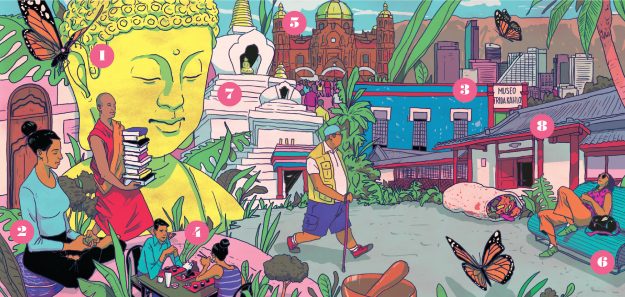Finding silence and inner peace in a metropolis of more than 21 million people can be challenging, but don’t forget that Mexico is a land of many indigenous cultures that are centuries old and deeply rooted in spiritual practice.
The first Buddhists documented in Mexico were ethnic Chinese who arrived in the 17th century from the Philippines on Spanish trade ships, but interest in Buddhist ideas and teachings first became fashionable in the 1960s, when Latin American intellectuals began studying Zen with groups of friends.
Today there are over 100,000 practicing Buddhists in Mexico—and probably tens of thousands more who are interested in the dharma, according to Marco Antonio Karam, the director of the well-known center Casa Tibet.
“Mexicans have a very deep spiritual vocation,” Karam said. “It is mostly linked to Catholicism and shamanism, but the Buddhist spirit is very attractive to Mexicans, who have found a particular connection to tantric Buddhism.”
The city’s Buddhist life flourishes most in the trendy Colonia Roma district, home to Casa Tibet and a half dozen other centers; venturing out from there, you can also find Zen temples and two Soka Gakkai centers.
1. | Casa Tibet México
Inaugurated in 1989 by His Holiness the 14th Dalai Lama, this center’s restored 19th-century house features meditation and lecture rooms, Tibetan art, and a library. The street-level Librería Potala sells books written in English and Spanish. This center is conveniently just around the corner from the city’s best bakery, Panadería Rosetta. Try the pink guava Danish or the cardamom rolls.
Orizaba 93
casatibet.org.mx
2. | Centro Budista de la Ciudad de México
Drop in for yoga or mindfulness class for 50 pesos (US $2.50) in this theater turned Triratna Buddhist center. Classes are in Spanish, but most instructors speak English, and you can purchase Mexican-made meditation cushions at the entrance.
Jalapa 94
budismo.org.mx
3. | Centro Budista
A second Centro Budista is located in the neighborhood of Coyoacán near the Museo Casa Azul (Casa Azul for short), painter Frida Kahlo’s iconic home. Come hungry and stop by Vege Taco, on the same street, for Mexican vegetarian dishes like mushroom pozole or soy-based tacos al pastor.
Felipe Carrillo Puerto 92
4. | Asociación México Japonesa
The Japanese-Mexican friendship club, formed in 1961, houses Mexico City’s oldest Japanese restaurant, set in a traditional garden. On weekends, families gather for steamy shabu shabu (hot pot) cooked at the table. The club also features a manga museum and an Asian store that sells Japanese tea, groceries, and household items.
Fujiyama 144
amj.mx
5. | Basílica de Guadalupe
Bear witness to acts of devotion from another faith at this shrine to the Virgin Mary, who is said to have appeared here in 1531. Rebuilt in 1622 and again in 1709, the shrine is visited by millions each year (many of them completing the pilgrimage on their knees). Reserve a free guided tour by calling 5118 0500, ext. 472.
Fray Juan de Zumarraga 2
virgendeguadalupe.org.mx
6. | Audiorama
Hidden inside Bosque de Chapultepec, Mexico City’s huge central park, is a silent meditation garden beside a pre-Hispanic cave that is believed to lead to Mictlan, the underworld of Aztec mythology. Rest here on colorful, ergonomically designed benches under coffee plants, bamboos, bees, and butterflies.
Bosque de Chapultepec, Gate A-3
chapultepec.cdmx.gob.mx
7. | Stupas
For a longer break, head out of town to see the classic stupas near Valle de Bravo, 85 miles west of Mexico City. Nestled within a lush tropical pine forest where Monarch butterflies spend their winters are Stupa de la Paz, built by Casa Tibet, and El Gran Stupa, constructed by a Bön Buddhist group. The latter holds free meditation Sundays at 12:30 p.m. Afterward you can visit the native food and handicraft markets in cobblestoned Valle de Bravo.
Valle de Bravo
ligmincha.org
8. | Camino Real Sumiya
This four-star Japanese inspired hotel about 50 miles south of Mexico City was built by the Woolworth heiress Barbara Hutton, who believed that Cuernavaca, capital of the Mexican state Morelos, had the planet’s perfect climate. The hotel is near an unusual museum of traditional and herbal medicines and the Tepozteco pyramid, and the hotel spa offers “temazcal” (sweat lodge) detox baths.
Cuernavaca
caminoreal.com
